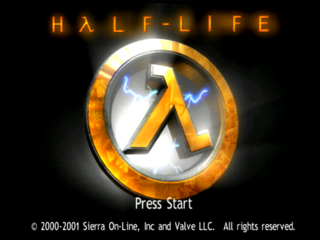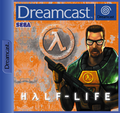Difference between revisions of "Half-Life"
From Sega Retro
m (→Promotional material: migrated) |
m (→Promotional screenshots: migrated to Development) |
||
| Line 22: | Line 22: | ||
{{ratings|DC}} | {{ratings|DC}} | ||
{{mainArticle|{{PAGENAME}}/Magazine articles}} | {{mainArticle|{{PAGENAME}}/Magazine articles}} | ||
| − | |||
| − | |||
| − | |||
| − | |||
| − | |||
| − | |||
| − | |||
| − | |||
| − | |||
==Artwork== | ==Artwork== | ||
Revision as of 23:56, 22 January 2022
| Half-Life |
|---|
| System(s): Sega Dreamcast |
| Publisher: Sierra On-Line (US), Havas Interactive (EU) |
| Developer: Captivation Digital Laboratories[1], Gearbox Software[1] |
| Developer(s) of original games: Valve Corporation, Gearbox Software |
| Planned release date(s): 2000-09[2][3], 2000-10[4], 2000-11-01[5], 2000-11-22[6], 2000-11-24[7], 2000-11-29[8], 2001-01[9], 2001-06-01[10], 2001-06-29[11] |
| Genre: Shoot-'em-Up |
| Number of players: 1 |
| State before cancellation: Late in development |
| Status of prototype(s): Prototype dumped |
Half-Life is a first person shooter developed by Valve Corporation. At the time of its release on PCs it was seen as groundbreaking, and still ranks as one of the highest rated PC games of all time.
The game was due to be ported to the Sega Dreamcast by Gearbox Software in a move that was much anticpated by Sega fans. However, a last minute decision saw the game be cancelled, despite playable (and finished) builds being showcased at trade shows and in magazine publications.
Magazine articles
| Sega Retro Average | ||||||||||||||||||||||||||||||||||
|---|---|---|---|---|---|---|---|---|---|---|---|---|---|---|---|---|---|---|---|---|---|---|---|---|---|---|---|---|---|---|---|---|---|---|
|
| 93 | |
|---|---|
| Based on 6 reviews | |
- Main article: Half-Life/Magazine articles.
Artwork
Technical information
The polygon models in the Dreamcast version have about twice as many polygons as the PC version. The zombies in the original PC version had 844 polygons, which was almost doubled to 1649 polygons in the Dreamcast version.[17] In the PC version, other characters had up to 1000 polygons and bosses up to 2500 polygons,[18] whereas the Dreamcast version's characters have up to 2836 polygons and bosses up to 3411 polygons.[19]
VMU Features
Half-Life is able to save progress anywhere in the game, however the further along in a chapter, the larger the file can get. Alternatively the game allows progress to be saved via a password system.
| Name | File Name | Comment | File Size | Icon |
|---|---|---|---|---|
| Half Life | HALFLIFE.### | HALF_LIFE_GAME | 30-200 |
References
- ↑ 1.0 1.1 The Cutting Room Floor: Half-Life (Dreamcast)
- ↑ Electronic Gaming Monthly, "September 2000" (US; 2000-08-08), page 50
- ↑ DC-UK, "May 2000" (UK; 2000-04-xx), page 62
- ↑ Official Dreamcast Magazine, "December 2000" (US; 2000-10-31), page 73
- ↑ Press release: 2000-08-29: SIERRA STUDIOS(tm) ANNOUNCES HALF-LIFE: BLUE SHIFT
- ↑ 6.0 6.1 Dreamcast Magazine, "No. 15" (UK; 2000-11-02), page 56
- ↑ Dreamcast Magazine, "No. 15" (UK; 2000-11-02), page 10
- ↑ Official Dreamcast Magazine, "November 2000" (UK; 2000-10-05), page 21
- ↑ Dreamcast Magazine, "No. 17" (UK; 2000-12-28), page 15
- ↑ Official Dreamcast Magazine, "June 2001" (UK; 2001-05-24), page 28
- ↑ Computer & Video Games, "November 2000" (UK; 2000-10-11), page 82
- ↑ Dreamcast Monthly, "November 2000" (UK; 2000-09-28), page 62
- ↑ DC-UK, "December 2000" (UK; 2000-10-23), page 58
- ↑ GamePro, "June 2001" (US; 2001-0x-xx), page 109
- ↑ SuperGamePower, "Junho 2001" (BR; 2001-xx-xx), page 34
- ↑ "Yes, but how many polygons?" An artist blog entry with interesting numbers
- ↑ Acceptable polygon count for FPS characters
- ↑ "Yes, but how many polygons?" An artist blog entry with interesting numbers (page 79)
| Half-Life | |
|---|---|
|
Main page | Comparisons | History | Hidden content | Bugs | Development | Magazine articles | Reception | Promotional material | Technical information | Bootlegs
Prototypes: 1659 prototype
| |




